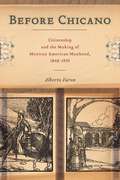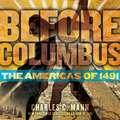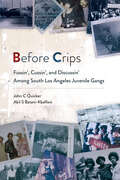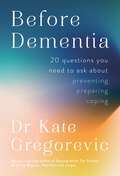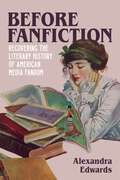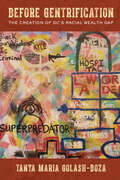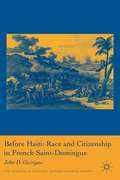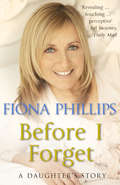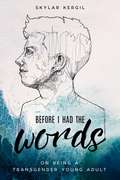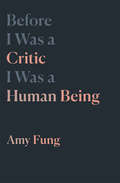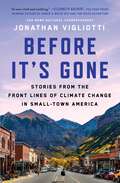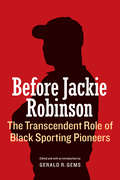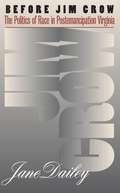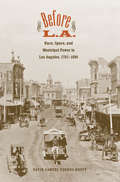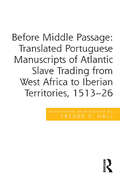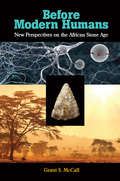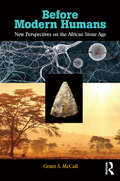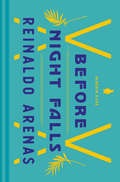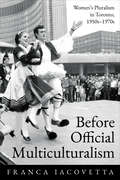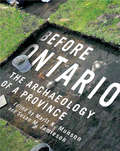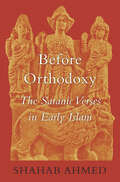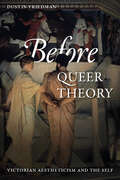- Table View
- List View
Before Chicano: Citizenship and the Making of Mexican American Manhood, 1848-1959 (America and the Long 19th Century #21)
by Alberto VaronUncovers the long history of how Latino manhood was integral to the formation of Latino identity In the first ever book-length study of Latino manhood before the Civil Rights Movement, Before Chicano examines Mexican American print culture to explore how conceptions of citizenship and manhood developed in the nineteenth and twentieth centuries. The year 1848 saw both the signing of the Treaty of Guadalupe Hidalgo that ended the U.S. Mexican War and the year of the Seneca Falls Convention, the first organized conference on women’s rights in the United States. These concurrent events signaled new ways of thinking about U.S. citizenship, and placing these historical moments into conversation with the archive of Mexican American print culture, Varon offers an expanded temporal frame for Mexican Americans as long-standing participants in U.S. national projects. Pulling from a wide-variety of familiar and lesser-known works—from fiction and newspapers to government documents, images, and travelogues—Varon illustrates how Mexican Americans during this period envisioned themselves as U.S. citizens through cultural depictions of manhood. Before Chicano reveals how manhood offered a strategy to disparate Latino communities across the nation to imagine themselves as a cohesive whole—as Mexican Americans—and as political agents in the U.S. Though the Civil Rights Movement is typically recognized as the origin point for the study of Latino culture, Varon pushes us to consider an intellectual history that far predates the late twentieth century, one that is both national and transnational. He expands our framework for imagining Latinos’ relationship to the U.S. and to a past that is often left behind.
Before Civilization: The Radiocarbon Revolution and Prehistoric Europe
by Colin RenfrewMonuments in Central and Western Europe have proved to be older than their supposed Near-Eastern forerunners, and the record must be almost completely rewritten in the light of these new dates. Before Civilization is an attempt to do this with the help of analogies from more recent and well-documented primitive societies.
Before Columbus: The Americas of 1491
by Charles C. MannA companion book to Mann's groundbreaking bestseller "1491: New Revelations of the Americas Before Columbus," this is a fascinating journey that presents the Americas as young readers have never seen them before. [This text is listed as an example that meets Common Core Standards in English language arts in grades 9-10 at http://www.corestandards.org.]
Before Crips: Fussin', Cussin', and Discussin' among South Los Angeles Juvenile Gangs (Studies in Transgression)
by John C. Quicker Akil S. Batani-KhalfaniThis groundbreaking book opens the door on the missing record of South Los Angeles juvenile gangs. It is the result of the unique friendship that developed between John Quicker and Akil Batani-Khalfani, aka Bird, who collaborated to show how structural marginality transformed hang-out street groups of non-White juveniles into gangs, paving the way for the rise of the infamous Crips and Bloods. Before Crips uses a macro historical analysis to sort through political and economic factors to explain the nature of gang creation. The authors mine a critical archive, using direct interviews with original gang members as well as theory and literature reviews, to contextualize gang life and gang formation. They discuss (and fuss and cuss about) topics ranging from the criminal economy and conceptions of masculinity to racial and gendered politics and views of violence. Their insider/outsider approach not only illuminates gang values and organization, but what they did and why, and how they grew in a backdrop of inequality and police brutality that came to a head with the 1965 Watts Rebellion. Providing an essential understanding of early South Los Angeles gang life, Before Crips explains what has remained constant, what has changed, and the roots of the violence that continues.
Before Dementia: 20 Questions You Need to Ask About Preventing, Preparing, Coping
by Dr. Kate Gregorevic, PhDStructured around 20 questions you need to ask to help prevent, prepare, and cope, this book is a friendly, authoritative guide for anyone facing dementia and those who care for them. Exploring why disease is a social construct just as much as a biological construct, it helps us understand what it means to live with or care for someone with dementia.How do I know if I have dementia, and how will I live with it if I do? Can people with dementia consent to sex? Can they choose euthanasia for their future selves? And can we prevent or push back its onset? Chances are you know someone with dementia, but how well do you really understand the condition? Dementia is a complex interplay of biological, social, and psychological factors, and understanding it means understanding more about society and ourselves. Approaching the topic through 20 insightful questions, geriatrician Dr. Kate Gregorevic explains the physical state of dementia, how to relate the diagnosis to real life, what questions to ask your doctor, strategies for preventing the condition, and how we can make our homes and society better for people with dementia. While this book tackles some uncomfortable questions, its purpose is to help—to prevent, to prepare, to cope and to understand—and provide you with strategies for moving forward.
Before Fanfiction: Recovering the Literary History of American Media Fandom
by Alexandra EdwardsBefore Fanfiction investigates the overlapping cultures of fandom and American literature from the late 1800s to the mid-1940s, exploding the oft-repeated myth that fandom has its origins in the male-dominated letter columns of science fiction pulp magazines in the 1930s. By reexamining the work of popular American women writers and their fans, Alexandra Edwards recovers the literary history of American media fandom, drawing previously ignored fangirls into the spotlight.
Before Gentrification: The Creation of DC's Racial Wealth Gap
by Tanya Maria Golash-BozaDraws a direct line between redlining, incarceration, and gentrification in an American city. This book shows how a century of redlining, disinvestment, and the War on Drugs wreaked devastation on Black people and paved the way for gentrification in Washington, DC. In Before Gentrification, Tanya Maria Golash-Boza tracks the cycles of state abandonment and punishment that have shaped the city, revealing how policies and policing work to displace and decimate the Black middle class. Through the stories of those who have lost their homes and livelihoods, Golash-Boza explores how DC came to be the nation's "murder capital" and incarceration capital, and why it is now a haven for wealthy White people. This troubling history makes clear that the choice to use prisons and policing to solve problems faced by Black communities in the twentieth century—instead of investing in schools, community centers, social services, health care, and violence prevention—is what made gentrification possible in the twenty-first. Before Gentrification unveils a pattern of anti-Blackness and racial capitalism in DC that has implications for all US cities.
Before Haiti: Race and Citizenship in French Saint-Domingue
by John D. GarrigusThis book details how France's most profitable plantation colony became Haiti, Latin America's first independent nation, through an uprising by slaves and the largest and wealthiest free population of people of African descent in the New World. Garrigus explains the origins of this free colored class, exposes the ways its members supported and challenged slavery, and examines how they shaped a new 'American' identity.
Before I Forget
by Fiona PhillipsFiona Phillips is one of our best-loved television presenters. Well-known for being warm, chatty and down to earth, she attended her local comprehensive in Southampton before studying English in Birmingham. For over twelve years she presented GMTV, during which time she interviewed some of the most famous and influential people on the planet, from film stars to royalty, politicians to local heroes. But in August 2008 Fiona announced that she was to quit the job she loved, revealing that her father, Phil, had been diagnosed with Alzheimer's just a year after her mother had died of the same disease and that she had decided to devote more time to him and to her family. Before I Forget is a wonderfully honest account of growing up in the 1960s and 70s within a complex family. During her childhood her father could sometimes be distant and demanding which both saddened her and drove her to succeed, her mother always the devoted wife and the steady heart of the family. When Fiona lands the job at GMTV she revels in how proud they are of her achievement. When her mother and then her father succumb to Alzheimer's we share in Fiona's sadness as she movingly describes watching them fade away, one moment interviewing George Clooney the next taking a call from Pembrokeshire Social Services to say that her mother had wandered away from her care home.Before I Forget is an extraordinary book which will resonate with Fiona's millions of fans and the millions of people who day-by-day are going through, or have gone through, the same experiences.
Before I Had the Words: On Being a Transgender Young Adult
by Skylar KergilAt the beginning of his physical transition from female to male, then-seventeen-year-old Skylar Kergil posted his first video on YouTube. In the months and years that followed, he recorded weekly update videos about the physical and emotional changes he experienced. Skylar’s openness and positivity attracted thousands of viewers, who followed along as his voice deepened and his body changed shape. Through surgeries and recovery, highs and lows, from high school to college to the real world, Skylar welcomed others on his journey.Before I Had the Words is the story of what came before the videos and what happened behind the scenes. From early childhood memories to the changes and confusion brought by adolescence, Skylar reflects on coming of age while struggling to understand his gender. As humorous as it is heartbreaking and as informative as it is entertaining, this memoir provides an intimate look at the experience of transitioning from one gender to another. Skylar opens up about the long path to gaining his family’s acceptance and to accepting himself, sharing stories along the way about smaller challenges like choosing a new name and learning to shave without eyebrow mishaps. Revealing entries from the author’s personal journals as well as interviews with members of his family lend remarkable depth to Skylar’s story. A groundbreaking chronicle of change, loss, discovery, pain, and relief, Before I Had the Words brings new meaning to the phrase “formative years.”
Before I Was a Critic I Was a Human Being
by Amy FungIn that moment, I felt closer to whiteness than not. I was completely complicit and didn’t think twice about entering a space that could cover their walls with images of contemporary Indigenous perspectives, but exclude their physical bodies from entering and experiencing. In that moment, I felt like a real Canadian.Before I Was a Critic I Was a Human Being is the debut collection of nonfiction essays by Amy Fung. In it, Fung takes a closer examination at Canada's mythologies of multiculturalism, settler colonialism, and identity through the lens of a national art critic.Following the tangents of a foreign-born perspective and the complexities and complicities in participating in ongoing acts of colonial violence, the book as a whole takes the form of a very long land acknowledgement. Taken individually, each essay roots itself in the learning and unlearning process of a first generation settler immigrant as she unfurls each region's sense of place and identity
Before I Was a Critic I Was a Human Being
by Amy FungIn that moment, I felt closer to whiteness than not. I was completely complicit and didn?t think twice about entering a space that could cover their walls with images of contemporary Indigenous perspectives, but exclude their physical bodies from entering and experiencing. In that moment, I felt like a real Canadian.Before I Was a Critic I Was a Human Being is the debut collection of nonfiction essays by Amy Fung. In it, Fung takes a closer examination at Canada's mythologies of multiculturalism, settler colonialism, and identity through the lens of a national art critic.Following the tangents of a foreign-born perspective and the complexities and complicities in participating in ongoing acts of colonial violence, the book as a whole takes the form of a very long land acknowledgement. Taken individually, each essay roots itself in the learning and unlearning process of a first generation settler immigrant as she unfurls each region's sense of place and identityPraise for Before I Was a Critic I Was a Human Being:?The hours I've spent with this knowing and moving book about place and placelessness are among the most valuable of my reading life. Wow, thank you, Amy." —Eileen Myles"As an Indigenous/Haudenosaunee writer and reader, I recognize that Amy Fung's book does not try to convince us that she is a native rights ally but shows us with language how to mould the term ally into a verb." —Janet Rogers, author of Totem Poles and Railroads"In this compelling work, Amy Fung breathes life and relevance into criticality. This visitor's guide is integral reading." —Cecily Nicholson, author of Wayside Sang, winner of the Governor General's Literary Award for Poetry.
Before It's Gone: Stories from the Front Lines of Climate Change in Small-Town America
by Jonathan VigliottiFrom CBS News national correspondent Jonathan Vigliotti, a &“vivid&” (Elizabeth Kolbert, Pulitzer Prize–winning author) and &“stunning&” (Booklist) character-driven call to action on our climate, told through the stories of the pioneering Americans working to persevere as leadership inaction risks the very survival of our heartland and hometowns.Discussion of the climate crisis has always suffered from a problem of abstraction. Data points and warnings of an overheated future struggle to break through the noise of everyday life. Deniers often portray climate solutions as inconvenient, expensive, and unnecessary. And many politicians, cloistered by status and focused always on their next election, do not yet see climate as a winning issue in the short run, so they don&’t take any action at all. But climate change, and its devastating consequences, has kept apace whether we want to pay attention or not. CBS News national correspondent Jonathan Vigliotti has seen that crisis unfold for himself, spending nearly two decades reporting across the United States (and the world) documenting the people, communities, landmarks, and traditions we&’ve already surrendered. Vigliotti shares with urgency and personal touch the story of an America on the brink. Before It&’s Gone traces Vigliotti&’s travels across the country, taking him to the frontlines of climate disaster and revealing the genuine impacts of climate change that countless Americans have already been forced to confront. From massive forest fires in California to hurricanes in Louisiana, receding coastlines in Massachusetts and devastated fisheries in Alaska, we learn that warnings of a future impacted by climate are no more; the climate catastrophe is already here. This is the story of America, and Americans, on the edge, and a powerful argument that radical action on climate change with a respect for its people and traditions is not only possible, but also the only way to preserve what we love.
Before Jackie Robinson: The Transcendent Role of Black Sporting Pioneers
by Gerald R. GemsWhile the accomplishments and influence of Jack Johnson, Joe Louis, Jesse Owens, Jackie Robinson, and Muhammad Ali are doubtless impressive solely on their merits, these luminaries of the black sporting experience did not emerge spontaneously. Their rise was part of a gradual evolution in social and power relations in American culture between the 1890s and 1940s that included athletes such as jockey Isaac Murphy, barnstorming pilot Bessie Coleman, and golfer Teddy Rhodes. The contributions of these early athletes to our broader collective history, and their heroic confrontations with the entrenched racism of their times, helped bring about the incremental changes that after 1945 allowed for sports to be more fully integrated.Before Jackie Robinson details and analyzes the lives of these lesser-known but important athletes within the broader history of black liberation. These figures not only excelled in their given sports but also transcended class and racial divides in making inroads into popular culture despite the societal restrictions placed on them. They were also among the first athletes to blur the line between athletics, entertainment, and celebrity culture. This volume presents a more nuanced account of early African American athletes’ lives and their ongoing struggle for acceptance, relevance, and personal and group identity.
Before Jim Crow: The Politics of Race in Postemancipation Virginia
by Jane DaileyLong before the Montgomery bus boycott ushered in the modern civil rights movement, black and white southerners struggled to forge interracial democracy in America. This innovative book examines the most successful interracial coalition in the nineteenth-century South, Virginia's Readjuster Party, and uncovers a surprising degree of fluidity in postemancipation southern politics. Melding social, cultural, and political history, Jane Dailey chronicles the Readjusters' efforts to foster political cooperation across the color line. She demonstrates that the power of racial rhetoric, and the divisiveness of racial politics, derived from the everyday experiences of individual Virginians--from their local encounters on the sidewalk, before the magistrate's bench, in the schoolroom. In the process, she reveals the power of black and white southerners to both create and resist new systems of racial discrimination. The story of the Readjusters shows how hard white southerners had to work to establish racial domination after emancipation, and how passionately black southerners fought each and every infringement of their rights as Americans.
Before L.A.
by David Samuel Torres-RouffDavid Torres-Rouff significantly expands borderlands history by examining the past and original urban infrastructure of one of Americas most prominent cities; its social, spatial, and racial divides and boundaries; and how it came to be the Los Angeles we know today. It is a fascinating study of how an innovative intercultural community developed along racial lines, and how immigrants from the United States engineered a profound shift in civic ideals and the physical environment, creating a social and spatial rupture that endures to this day.
Before Middle Passage: Translated Portuguese Manuscripts Of Atlantic Slave Trading From West Africa To Iberian Territories, 1513-26
by Trevor P. HallOn the 20th of January 1526, the Santiago left Lisbon bound for Africa with a cargo of brass and tin bracelets, round bells, barber basins and cloth; by early October the ship was back in Portugal with a very different cargo, 108 enslaved Africans. With chilling detachment the ship’s trading log records the commodification of human beings, the prices paid for them, the sums received for their sale and the number who did not survive the crossing. Whilst this log may be extremely rare, it is clear from another surviving document, the receipt book of the customs office of the Portuguese Cape Verde Islands, that such voyages were commonplace in the early years of the sixteenth century. The bulk of this volume consists of a translation into English of the receipt book from the customs office of the Cape Verde Islands. In it Portuguese customs agents recorded import duties on over 3,000 slaves transported from nearby West Africa in 36 ships. The customs officers named the slave traders, ships, officers, crew, and outfitters of the ships, as well as the price of each slave and the import duty collected by the Portuguese government and the Catholic Church. A second section of the customs book provides details of export taxes paid on c.600 African slaves by merchants from Portugal, Spain, and the Spanish Canary Islands, when they exchanged European merchandise for slaves. The final chapter of the volume translates the Santiago’s log, providing an example of an actual slave trading expedition. Taken together these documents open a rare window into the workings and scope of the early Atlantic slave trade.
Before Modern Humans: New Perspectives on the African Stone Age
by Grant S. McCallThis fascinating volume, assessing Lower and Middle Pleistocene African prehistory, argues that the onset of the Middle Stone Age marks the origins of landscape use patterns resembling those of modern human foragers. Inaugurating a paradigm shift in our understanding of modern human behavior, Grant McCall argues that this transition—related to the origins of “home base” residential site use—occurred in mosaic fashion over the course of hundreds of thousands of years. He concludes by proposing a model of brain evolution driven by increasing subsistence diversity and intensity against the backdrop of larger populations and Pleistocene environmental unpredictability. McCall argues that human brain size did not arise to support the complex patterns of social behavior that pervade our lives today, but instead large human brains were co-opted for these purposes relatively late in prehistory, accounting for the striking archaeological record of the Upper Pleistocene.
Before Modern Humans: New Perspectives on the African Stone Age
by Grant S. McCallThis fascinating volume, assessing Lower and Middle Pleistocene African prehistory, argues that the onset of the Middle Stone Age marks the origins of landscape use patterns resembling those of modern human foragers. Inaugurating a paradigm shift in our understanding of modern human behavior, Grant McCall argues that this transition—related to the origins of “home base” residential site use—occurred in mosaic fashion over the course of hundreds of thousands of years. He concludes by proposing a model of brain evolution driven by increasing subsistence diversity and intensity against the backdrop of larger populations and Pleistocene environmental unpredictability. McCall argues that human brain size did not arise to support the complex patterns of social behavior that pervade our lives today, but instead large human brains were co-opted for these purposes relatively late in prehistory, accounting for the striking archaeological record of the Upper Pleistocene.
Before Night Falls: A Memoir (Penguin Vitae)
by Reinaldo ArenasThe shocking memoir by visionary Cuban writer Reinaldo Arenas "is a book above all about being free," said The New York Review of Books--sexually, politically, artistically. Arenas recounts a stunning odyssey from his poverty-stricken childhood in rural Cuba and his adolescence as a rebel fighting for Castro, through his supression as a writer, imprisonment as a homosexual, his flight from Cuba via the Mariel boat lift, and his subsequent life and the events leading to his death in New York. In what The Miami Herald calls his "deathbed ode to eroticism," Arenas breaks through the code of secrecy and silence that protects the privileged in a state where homosexuality is a political crime. Recorded in simple, straightforward prose, this is the true story of the Kafkaesque life and world re-created in the author's acclaimed novels.
Before Official Multiculturalism: Women’s Pluralism in Toronto, 1950s-1970s (Studies in Gender and History)
by Franca IacovettaFor almost two decades before Canada officially adopted multiculturalism in 1971, a large network of women and their allies in Toronto were promoting pluralism as a city- and nation-building project. Before Official Multiculturalism assesses women as liberal pluralist advocates and activists, critically examining the key roles they played as community organizers, frontline social workers, and promoters of ethnic festivals. The book explores women’s community-based activism in support of a liberal pluralist vision of multiculturalism through an analysis of the International Institute of Metropolitan Toronto, a postwar agency that sought to integrate newcomers into the mainstream and promote cultural diversity. Drawing on the rich records of the Institute, as well as the massive International Institutes collection in Minnesota, the book situates Toronto within its Canadian and North American contexts and addresses the flawed mandate to integrate immigrants and refugees into an increasingly diverse city. Before Official Multiculturalism engages with national and international debates to provide a critical analysis of women’s pluralism in Canada.
Before Ontario
by Marit Munson Susan JamiesonBefore Ontario there was ice. As the last ice age came to an end, land began to emerge from the melting glaciers. With time, plants and animals moved into the new landscape and people followed. For almost 15,000 years, the land that is now Ontario has provided a home for their descendants: hundreds of generations of First Peoples. With contributions from the province's leading archaeologists, Before Ontario provides both an outline of Ontario's ancient past and an easy to understand explanation of how archaeology works. The authors show how archaeologists are able to study items as diverse as fish bones, flakes of stone, and stains in the soil to reconstruct the events and places of a distant past - fishing parties, long-distance trade, and houses built to withstand frigid winters. Presenting new insights into archaeology's purpose and practice, Before Ontario bridges the gap between the modern world and a past that can seem distant and unfamiliar, but is not beyond our reach. Contributors include Christopher Ellis (University of Western Ontario), Neal Ferris (University of Western Ontario/Museum of Ontario Archaeology), William Fox (Canadian Museum of Civilization/Royal Ontario Museum), Scott Hamilton (Lakehead University), Susan Jamieson (Trent University Archaeological Research Centre - TUARC), Mima Kapches (Royal Ontario Museum), Anne Keenleyside (TUARC), Stephen Monckton (Bioarchaeological Research), Marit Munson (TUARC), Kris Nahrgang (Kawartha Nishnawbe First Nation), Suzanne Needs-Howarth (Perca Zooarchaeological Research), Cath Oberholtzer (TUARC), Michael Spence (University of Western Ontario), Andrew Stewart (Strata Consulting Inc.), Gary Warrick (Wilfrid Laurier University), and Ron Williamson (Archaeological Services Inc).
Before Ontario: The Archaeology of a Province (McGill-Queen's Indigenous and Northern Studies)
by Marit K. Munson Susan M. JamiesonBefore Ontario there was ice. As the last ice age came to an end, land began to emerge from the melting glaciers. With time, plants and animals moved into the new landscape and people followed. For almost 15,000 years, the land that is now Ontario has provided a home for their descendants: hundreds of generations of First Peoples. With contributions from the province's leading archaeologists, Before Ontario provides both an outline of Ontario's ancient past and an easy to understand explanation of how archaeology works. The authors show how archaeologists are able to study items as diverse as fish bones, flakes of stone, and stains in the soil to reconstruct the events and places of a distant past - fishing parties, long-distance trade, and houses built to withstand frigid winters. Presenting new insights into archaeology’s purpose and practice, Before Ontario bridges the gap between the modern world and a past that can seem distant and unfamiliar, but is not beyond our reach. Contributors include Christopher Ellis (University of Western Ontario), Neal Ferris (University of Western Ontario/Museum of Ontario Archaeology), William Fox (Canadian Museum of Civilization/Royal Ontario Museum), Scott Hamilton (Lakehead University), Susan Jamieson (Trent University Archaeological Research Centre - TUARC), Mima Kapches (Royal Ontario Museum), Anne Keenleyside (TUARC), Stephen Monckton (Bioarchaeological Research), Marit Munson (TUARC), Kris Nahrgang (Kawartha Nishnawbe First Nation), Suzanne Needs-Howarth (Perca Zooarchaeological Research), Cath Oberholtzer (TUARC), Michael Spence (University of Western Ontario), Andrew Stewart (Strata Consulting Inc.), Gary Warrick (Wilfrid Laurier University), and Ron Williamson (Archaeological Services Inc).
Before Orthodoxy: The Satanic Verses in Early Islam
by Shahab Ahmed“The most systematic, critical study of an especially important tradition from early Islamic history, the so-called incident of the Satanic verses.” —ChoiceOne of the most controversial episodes in the life of the Prophet Muhammad concerns an incident in which he allegedly mistook words suggested by Satan as divine revelation. Known as the Satanic verses, these praises to the pagan deities contradict the Islamic belief that Allah is one and absolute. Muslims today?of all sects?deny that the incident of the Satanic verses took place. But as Shahab Ahmed explains, Muslims did not always hold this view.Before Orthodoxy wrestles with the question of how religions establish truth?especially religions such as Islam that lack a centralized authority to codify beliefs. Taking the now universally rejected incident of the Satanic verses as a case study in the formation of Islamic orthodoxy, Ahmed shows that early Muslims, circa 632 to 800 CE, held the exact opposite belief. For them, the Satanic verses were an established fact in the history of the Prophet. Ahmed offers a detailed account of the attitudes of Muslims to the Satanic verses in the first two centuries of Islam and traces the chains of transmission in the historical reports known as riwayah.Touching directly on the nature of Muhammad’s prophetic visions, the interpretation of the Satanic verses incident is a question of profound importance in Islam, one that plays a role in defining the limits of what Muslims may legitimately say and do?issues crucial to understanding the contemporary Islamic world.
Before Queer Theory: Victorian Aestheticism and the Self
by Dustin FriedmanA reimagining of how the aesthetic movement of the Victorian era ushered in modern queer theory.Late Victorian aesthetes were dedicated to the belief that an artwork's value derived solely from its beauty, rather than any moral or utilitarian purpose. Works by these queer artists have rarely been taken seriously as contributions to the theories of sexuality or aesthetics. But in Before Queer Theory, Dustin Friedman argues that aestheticism deploys its "art for art's sake" rhetoric to establish a nascent sense of sexual identity and community.Friedman makes the case for a claim rarely articulated in either Victorian or modern culture: that intellectually, creatively, and ethically, being queer can be an advantage not in spite but because of social hostility toward nonnormative desires. Showing how aesthetes—among them Walter Pater, Oscar Wilde, Vernon Lee, and Michael Field—harnessed the force that Georg Wilhelm Friedrich Hegel called "the negative," Friedman reveals how becoming self-aware of one's sexuality through art can be both liberating and affirming of humanity's capacity for subjective autonomy.Challenging one of the central precepts of modern queer theory—the notion that the heroic subject of Enlightenment thought is merely an effect of discourse and power—Friedman develops a new framework for understanding the relationship between desire and self-determination. He also articulates an innovative, queer notion of subjective autonomy that encourages reflecting critically on one's historical moment and envisioning new modes of seeing, thinking, and living that expand the boundaries of social and intellectual structures. Before Queer Theory is an audacious reimagining that will appeal to scholars with interests in Victorian studies, queer theory, gender and sexuality studies, and art history.
